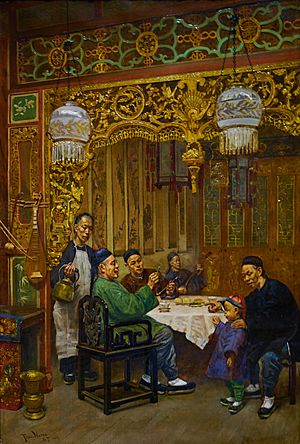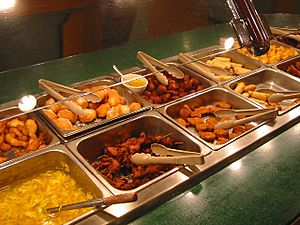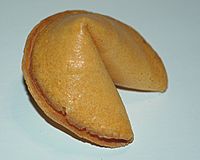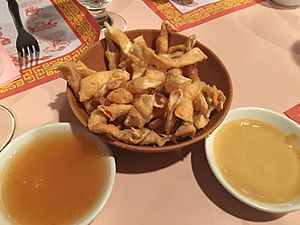American Chinese cuisine facts for kids
American Chinese cuisine is a special kind of Chinese cooking that was created by Chinese Americans. The dishes you find in many Chinese restaurants in North America are often changed to fit American tastes. This means they can be quite different from the food you'd find in China!
Contents
History of American Chinese Food
Many Chinese immigrants came to the United States looking for jobs, especially as miners and railroad workers. As more groups arrived, laws were made that stopped them from owning land. So, they often lived together in special neighborhoods called "Chinatowns". In these areas, immigrants started their own small businesses, like restaurants and laundry services.
By the 1800s, the Chinese community in San Francisco had fancy restaurants. These places were mostly for Chinese customers. But in smaller towns, Chinese immigrants opened restaurants that served whatever their customers wanted. This could be anything from pork chop sandwiches and apple pie to beans and eggs! Many of these small-town restaurant owners were self-taught cooks. They made up new ways of cooking using the ingredients they could find.
These smaller restaurants were key to creating American Chinese cuisine. They changed Chinese food to better suit American tastes. At first, they served miners and railroad workers. Then, they opened new restaurants in towns where Chinese food was totally new. They used local ingredients and made food that their customers would enjoy. Even though these new dishes weren't exactly like traditional Chinese food, these restaurants helped Americans learn about Chinese culture.
Chinese restaurants in the U.S. started during the California Gold Rush. This event brought 20,000 to 30,000 immigrants from the Canton region of China. By 1850, San Francisco had five Chinese restaurants. Soon, a lot of food was being shipped from China to America's west coast.
This trend slowly moved eastward as American railways grew, especially to New York City. The Chinese Exclusion Act allowed merchants to enter the country. In 1915, restaurant owners could get merchant visas. This encouraged more Chinese restaurants to open as a way for people to immigrate. The Pekin Noodle Parlor, opened in 1911, is the oldest Chinese restaurant still running in the country. As of 2015, the United States had 46,700 Chinese restaurants.
Over time, cooks changed southern Chinese dishes like chop suey. They created a style of Chinese food not found in China. Restaurants (along with Chinese laundries) gave Chinese people a special business area. This was important because Chinese people were often kept out of most jobs due to unfair treatment or not knowing English well. By the 1920s, this food, especially chop suey, became popular with middle-class Americans. However, after World War II, some people started to say it wasn't "real" Chinese food.
Later in the 1900s, people became more open to different tastes. It became clear that Chinese restaurants were no longer just for Chinese customers. American-Chinese restaurants also helped start the trend of take-out and delivery food in America.
In New York City, delivery became popular in the 1970s. Empire Szechuan Gourmet Franchise hired Taiwanese students from Columbia University to deliver food. Chinese American restaurants were also among the first to use picture menus.
Starting in the 1950s, immigrants from Taiwan began working in American Chinese restaurants. They took over from Cantonese immigrants. These new immigrants helped American-Chinese cuisine grow beyond just Cantonese cuisine. They added dishes from many different parts of China, and even some Japanese-inspired dishes.
In 1955, the Republic of China moved people from the Dachen Islands because Communists were getting closer. Many who went to Taiwan later moved to the United States. They didn't have strong connections or many chances in Taiwan. Chefs from the Dachen Islands greatly influenced American Chinese food.
Taiwanese immigration mostly ended in the 1990s. This was because Taiwan's economy grew, and it became more democratic. From the 1990s on, immigrants from China again made up most of the cooks in American Chinese restaurants. Many of these new immigrants were from Fujian Province (like Fuzhou people) and Zhejiang Province (like Wenzhounese). They often came to work in Chinese restaurants in New York City starting in the 1980s.
American Chinese cuisine developed by using Chinese cooking methods with local ingredients and tastes. Many Chinese restaurant menus in the U.S. are printed in Chinatown, Manhattan. This area has a large Chinese-American population.
In 2011, the Smithsonian National Museum of American History showed the history and culture of American Chinese cuisine. Their exhibit was called Sweet & Sour: A Look at the History of Chinese Food in the United States.
How American Chinese Food is Different
American Chinese food mostly comes from the cooking styles of Guangdong, a southern province in China. Many early Chinese immigrants, especially before 1924, came from the Toisan district of Guangdong. These families created new styles and used ingredients that were easy to find, especially in California.
The Chinese-American cooking served in restaurants was different from the food Chinese-American families ate at home. Of the many regional cuisines in China, Cantonese cuisine had the biggest impact on American Chinese food.
One common difference is how vegetables are used. In American Chinese food, vegetables are often a side dish or decoration. But in traditional Chinese cooking, vegetables are usually cooked right into the main dish. You can see this with carrots and tomatoes. Chinese cooking often uses Asian leaf vegetables like bok choy and kai-lan. It also focuses more on fresh meat and seafood.
Stir frying, pan frying, and deep frying are very common Chinese cooking techniques in American Chinese cuisine. These are all easy to do using a wok. A wok is a Chinese frying pan that looks like a bowl and gets very hot.
This food also used to be known for having a lot of MSG to make it taste better. However, now many restaurants offer "MSG Free" or "No MSG" options. They will also leave it out if you ask.
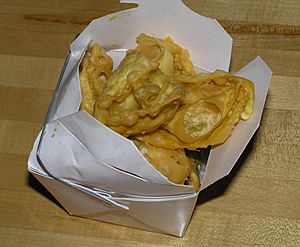
American Chinese cuisine uses ingredients that are not from China and are rarely used there. For example, Western broccoli is common instead of Chinese broccoli (Gai-lan). Sometimes, Western broccoli is even called sai1 laan4 fa1 in Cantonese. This helps avoid confusing it with the Chinese type. Among Chinese speakers, it's usually clear which type of broccoli is meant unless specified.
The same goes for carrots and onions. In Chinese, lo baak can mean several root vegetables, including carrots. The orange Western carrot is sometimes called "foreign radish" in parts of China. When the word for onion, cong, is used, it usually means "green onions" (also called scallions). The larger, round onion common in the U.S. is called yang cong, which means "foreign onion". These names show that American broccoli, carrots, and onions are not originally from China. So, they are less common in traditional Chinese cooking.
Egg fried rice in American Chinese cuisine is also made differently. It often has more soy sauce for flavor. Traditional egg fried rice uses less soy sauce. Some food styles, like dim sum, were also changed for American tastes. For example, fried dishes might have more batter, and extra soy sauce is often added.
Salads with raw or uncooked ingredients are rare in traditional Chinese food. So are Japanese-style sushi or sashimi. However, more and more American Chinese restaurants, even fancy ones, are now offering these items because customers want them.
Ming Tsai, a famous chef, said that American Chinese restaurants usually try to have food from 3-5 regions of China. They might have chop suey, or "fried vegetables and some protein in a thick sauce." They might also have "eight different sweet and sour dishes" or "a whole page of 20 different chow meins or fried rice dishes." Tsai said that "Chinese-American cuisine is 'simplified' Chinese food. It's changed... to be milder, thicker, and sweeter for the American public."
Most American Chinese restaurants serve non-Chinese customers. Their menus are in English or have pictures. If there are separate Chinese-language menus, they might have items like liver, chicken feet, or other meat dishes that American customers might not want. In Chinatown, Manhattan, some restaurants are known for having a "secret" menu with food that ethnic Chinese prefer. This food is thought to be disliked by non-Chinese Americans.
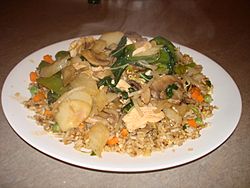
Popular Dishes
American Chinese Restaurant Dishes Not Found in China
Here are some dishes you often see on American Chinese menus that aren't common in China:
- Almond chicken—Chicken coated in a batter with ground almonds, then fried. It's served with almonds and onions.
- Beef & broccoli—Thinly sliced flank steak stir-fried with broccoli. It's covered in a dark sauce made with soy sauce and oyster sauce, thickened with cornstarch.
- Chicken & broccoli—Like beef & broccoli, but with chicken instead of beef.
- Chinese chicken salad—Usually has sliced chicken, fresh leafy greens, crispy noodles (or fried wonton skins), and sesame dressing. Some places add mandarin oranges.
- Chop suey—Means "mixed pieces" in Chinese. It's usually a mix of vegetables and meat in a brown or white sauce.
- Crab rangoon—Fried wonton skins filled with (often fake) crab meat and cream cheese.
- Fortune cookie—These were created in California. They are a sweet, Western version of a Japanese cookie. Now, you find them in many American Chinese restaurants.
- Fried wontons—Similar to crab rangoon. A filling (often pork) is wrapped in a wonton skin and deep-fried.
- General Tso's chicken—Pieces of chicken dipped in batter, deep-fried, and seasoned with ginger, garlic, sesame oil, scallions, and hot chili peppers. It's thought to be named after a military leader from the Qing dynasty named Zuo Zongtang.
- Mongolian beef—Fried beef with scallions or white onions in a spicy and often sweet brown sauce.
- Pepper steak—Sliced steak, green bell peppers, tomatoes, and white or green onions stir-fried with salt, sugar, and soy sauce. Sometimes, bean sprouts are added.
- Royal beef—Deep-fried sliced beef, covered in a wine sauce. Often served with steamed broccoli.
- Sesame chicken—Boneless, marinated, battered, and deep-fried chicken. It's then covered in a clear red or orange, sweet, and slightly spicy sauce. This sauce is made from soy sauce, corn starch, vinegar, chicken broth, and sugar.
- Sushi—Even though it's Japanese food, some American Chinese restaurants, especially buffets, serve different types of sushi.
- Sweet roll—Yeast rolls, usually fried, covered in sugar. Some have cream cheese or icing inside.
- Wonton strips—Often given for free with duck sauce and hot mustard, or with soup when you order take-out.
Other American Chinese Dishes
Some authentic restaurants with Chinese-language menus might offer "yellow-hair chicken". This is basically a free-range chicken. It's different from the usual American mass-farmed chicken. Yellow-hair chicken is liked for its flavor. But it needs to be cooked carefully to be tender because it has less fat and more muscle. This dish usually isn't on the English menu.
Dau miu (pea shoots) is a Chinese vegetable that became popular in the early 1990s. Now, it's on English menus, usually as "pea shoots." Even fancy non-Asian restaurants serve it. It used to be available only a few months a year. But now it's grown in greenhouses and can be found all year.
North American Versions of Dishes Also Found in China
- Beijing beef—In China, this dish uses gai lan (Chinese broccoli) instead of American broccoli.
- Cashew chicken—Tender chicken pieces stir-fried with cashews.
- Chow mein—Literally means "stir-fried noodles." Chow mein has fried crispy noodles with bits of meat and vegetables. It can come with chicken, pork, shrimp, or beef.
- Egg foo young—A Chinese-style omelet with vegetables and meat. It's usually served with a brown gravy. In North America, some restaurants deep-fry the omelet. But in Asia, it's more likely to be fried in a wok.
- Egg roll—Spring rolls have a thin, light, crispy skin that flakes apart. They are filled with mushrooms, bamboo, and other vegetables. American-style egg rolls have a thicker, chewier, dark brown bubbly skin. They are stuffed with cabbage and usually bits of meat or seafood (like pork or shrimp), but no egg.
- Fried rice—Fried-rice dishes are popular in American Chinese food. They are quick and easy to make, and Americans like them.
- Fried rice is usually made with rice that has cooled overnight. This lets restaurants use leftover rice well. Freshly cooked rice isn't as good for fried rice.
- The Chinese-American version often uses more soy sauce than the versions found in China.
- Fried rice comes with different mixes of meat (pork, chicken, and shrimp are most popular) and vegetables.
- Ginger beef—Tender beef cut into chunks, mixed with ginger and Chinese mixed vegetables.
- Ginger fried beef—Tender beef cut into thin strips, battered, deep-fried. Then, it's fried again in a wok with a sweet sauce. This is a version of a popular Northern Chinese dish.
- Hulatang—A traditional Chinese soup with hot spices. It's often called "spicy soup" on menus.
- Kung Pao chicken—The Sichuan dish is very spicy. But the versions in North America are usually less spicy, or not spicy at all. They sometimes leave out the Sichuan pepper that is key to the original dish.
- Lo mein ("stirred noodles")—Often made with eggs and flour, which makes them chewier. Thick, spaghetti-shaped noodles are pan-fried with vegetables (mainly bok choy and Chinese cabbage) and meat. Sometimes this dish is called chow mein.
- Mei Fun—Noodles usually simmered in broth with other ingredients like fish balls, beef balls, or fish slices.
- Moo shu pork—The original version uses more typical Chinese ingredients (like wood ear fungi and daylily buds) and thin flour pancakes. The American version uses vegetables more familiar to Americans and thicker pancakes. This dish is very popular in Chinese restaurants in the United States, but not as much in China.
- Orange chicken—Chopped, battered, fried chicken with a sweet orange-flavored chili sauce that is thickened and glazed. The traditional version has stir-fried chicken in a light, slightly sweet soy sauce flavored with dried orange peels.
- Wonton soup—In most American Chinese restaurants, you only get wonton dumplings in broth. But in China, versions might come with noodles.
- In Canton, it can be a full meal. It has thin egg noodles and several pork and prawn wontons in a pork or chicken soup broth. Especially in take-out restaurants, wontons are often made with thicker dough skins.
Regional Differences in American Chinese Food
New York City
The New York metropolitan area has the largest Chinese population outside of Asia. It's also the biggest Asian-American group in the United States. New York City is the main place Chinese immigrants come to in the U.S. Because of this, you can find all kinds of Chinese food styles there. This includes Hakka, Taiwanese, Shanghainese, Hunanese, Szechuan, Cantonese, Fujianese, Xinjiang, Zhejiang, and even Korean Chinese cuisine. Even the less common Dongbei style from Northeast China is now available in Flushing, Queens. You can also find Mongolian cuisine and Uyghur cuisine.
You can see these many regional Chinese food styles most clearly in the city's Chinatowns in Queens, especially the Flushing Chinatown. But they are also noticeable in the Chinatowns in Brooklyn and Manhattan.
Kosher Chinese Food
Kosher Chinese food is also widely available in New York City. This is because the area has a large Jewish population, especially Orthodox Jewish people.
There's a common idea that American Jews eat at Chinese restaurants on Christmas Day. This tradition might have started because not many other restaurants were open on Christmas Day. Also, Jewish and Chinese immigrants lived close to each other in New York City. Plus, Chinese food often doesn't mix dairy foods with meat, which fits kosher rules.
Kosher Chinese food in New York City, and other cities with Orthodox Jewish neighborhoods, is usually made under strict rules. A rabbi supervises it to make sure it is Kosher certified.
Los Angeles County
Chinese people in Los Angeles come from at least 21 of China's 34 provinces. This makes the Greater Los Angeles area home to a very diverse group of Chinese people.
Chinese-American food in the Greater Los Angeles area is found more in Chinese ethnoburbs (suburban Chinatowns) than in older, traditional Chinatowns. The oldest Chinese ethnoburb is Monterey Park. It's seen as the first suburban Chinatown in the country.
While Chinatown in Los Angeles is still important for Chinese immigrants, most have moved to areas with many Chinese immigrants in the San Gabriel Valley. This area stretches from Monterey Park to cities like Alhambra, San Gabriel, Rosemead, San Marino, South Pasadena, West Covina, Walnut, City of Industry, Diamond Bar, Arcadia, and Temple City.
The Valley Boulevard corridor is the main street for Chinese restaurants in the San Gabriel Valley. Another area with many Chinese people is Irvine in Orange County. Over 525,000 Asian Americans live in the San Gabriel Valley alone. More than 67% of them were born outside the U.S. The valley has become a famous tourist spot in China. Of the ten U.S. cities with the most Chinese Americans, the top eight are in the San Gabriel Valley. This makes it one of the biggest centers for Chinese Americans in North America.
Some regional Chinese food styles you can find include Beijing, Chengdu, Chonqing, Dalian, Hangzhou, Hong Kong, Hunan, Mongolian hot pot, Nanjing, Shanghai, Shanxi, Shenyang, Wuxi, Xinjiang, Yunnan, and Wuhan.
San Francisco Bay Area
Since the early 1990s, many American Chinese restaurants influenced by California cuisine have opened in the San Francisco Bay Area. The classic American Chinese dishes are still on the menu. But there's more focus on fresh vegetables, and many options are good for vegetarians.
This new style of cooking uses interesting ingredients like mangos and portobello mushrooms. Brown rice is often offered instead of white rice.
Some restaurants use grilled wheat flour tortillas instead of rice pancakes for mu shu dishes. This happens even in some restaurants that aren't usually called California Chinese. It's seen in both more Western-style places and more authentic ones. There's a Mexican bakery that sells thinner tortillas to some restaurants specifically for mu shu. However, some mu shu fans don't like this change.
Also, many restaurants serving more traditional Chinese foods exist. This is because there are many ethnic Chinese people in the San Francisco Bay Area.
You can easily find restaurants specializing in Cantonese, Sichuanese, Hunanese, Northern Chinese, Shanghainese, Taiwanese, and Hong Kong traditions. There are also more specific places like seafood restaurants, Hong Kong-style diners and cafes (also known as Cha chaan teng), dim sum teahouses, and hot pot restaurants. Many Chinatown areas also have Chinese bakeries, boba milk tea shops, roasted meat, vegetarian cuisine, and special dessert shops.
Chop suey is not widely available in San Francisco. Also, the chow mein there is different from the chow mein found in the Midwest.
Boston
Chinese food in Boston is shaped by money and regional factors. The growing Boston Chinatown has Chinese-owned bus lines. These buses take more and more people to and from the many Chinatowns in New York City. This has led to some sharing of food ideas between Boston and New York Chinese cuisine.
A large group of Fujianese immigrants has made Boston their home. This means Fuzhou cuisine is easy to find there. More Vietnamese people are also living in Boston. This has influenced Chinese food in Greater Boston.
Finally, new dishes that mix chow mein and chop suey with locally grown produce and local seafood are found in Chinese and non-Chinese restaurants around Boston.
Joyce Chen brought northern Chinese (Mandarin) and Shanghainese dishes to Boston in the 1950s. These included Peking duck, moo shu pork, hot and sour soup, and potstickers. She called potstickers "Peking Ravioli" or "Ravs." Her restaurants were visited by early workers on the ARPANET, famous people like John Kenneth Galbraith, James Beard, Julia Child, Henry Kissinger, Beverly Sills, and Danny Kaye. A former president of Harvard University called her restaurant "not just a restaurant, but a cultural exchange center."
Philadelphia
The changing American Chinese food scene in Philadelphia is similar to New York City and Boston. Like Boston, Philadelphia is seeing a lot of Chinese immigration from New York City, which is 95 miles north. Also, China is the top country of birth for new arrivals there.
There is a growing Fujianese community in Philadelphia. So, Fuzhou cuisine is easy to find in the Philadelphia Chinatown. Also, new Vietnamese cuisine in Philadelphia is helping Chinese food there change. Some Chinese-American restaurants are adding Vietnamese influences or recipes.
Hawaii
Hawaiian-Chinese food developed a bit differently from Chinese food in the continental United States.
Because of the many different Pacific cultures in Hawaii and the history of Chinese influence there, local Chinese food is part of the cuisine of Hawaii. This is a mix of different cooking traditions. Some Chinese dishes are often served as part of plate lunches in Hawaii.
The names of foods are also different. For example, Manapua comes from a Hawaiian phrase meaning "delicious pork item." It refers to the dim sum bao, though the meat isn't always pork.
Other Regional American Chinese Dishes
- Chow mein sandwich—A sandwich with chow mein and gravy (found in Southeastern Massachusetts and Rhode Island).
- Chop suey sandwich—A sandwich with chicken chop suey on a hamburger bun (found on the North Shore of Massachusetts).
- St. Paul sandwich—An egg foo young patty in plain white sandwich bread (found in St. Louis, Missouri).
- Springfield-style cashew chicken—A type of cashew chicken that mixes breaded deep-fried chicken, cashews, and oyster sauce (found in Springfield, Missouri).
- War/wor sue gai (boneless almond chicken)—Bite-sized Southern-style fried chicken with yellow sauce (found in Columbus, Ohio).
- Yaka mein—Chinese-Creole food found in New Orleans that came from beef noodle soup.
Images for kids
-
A typical Panda Express meal: Kung Pao chicken, orange chicken, chow mein and steamed vegetables
See also
 In Spanish: Gastronomía sinoestadounidense para niños
In Spanish: Gastronomía sinoestadounidense para niños


